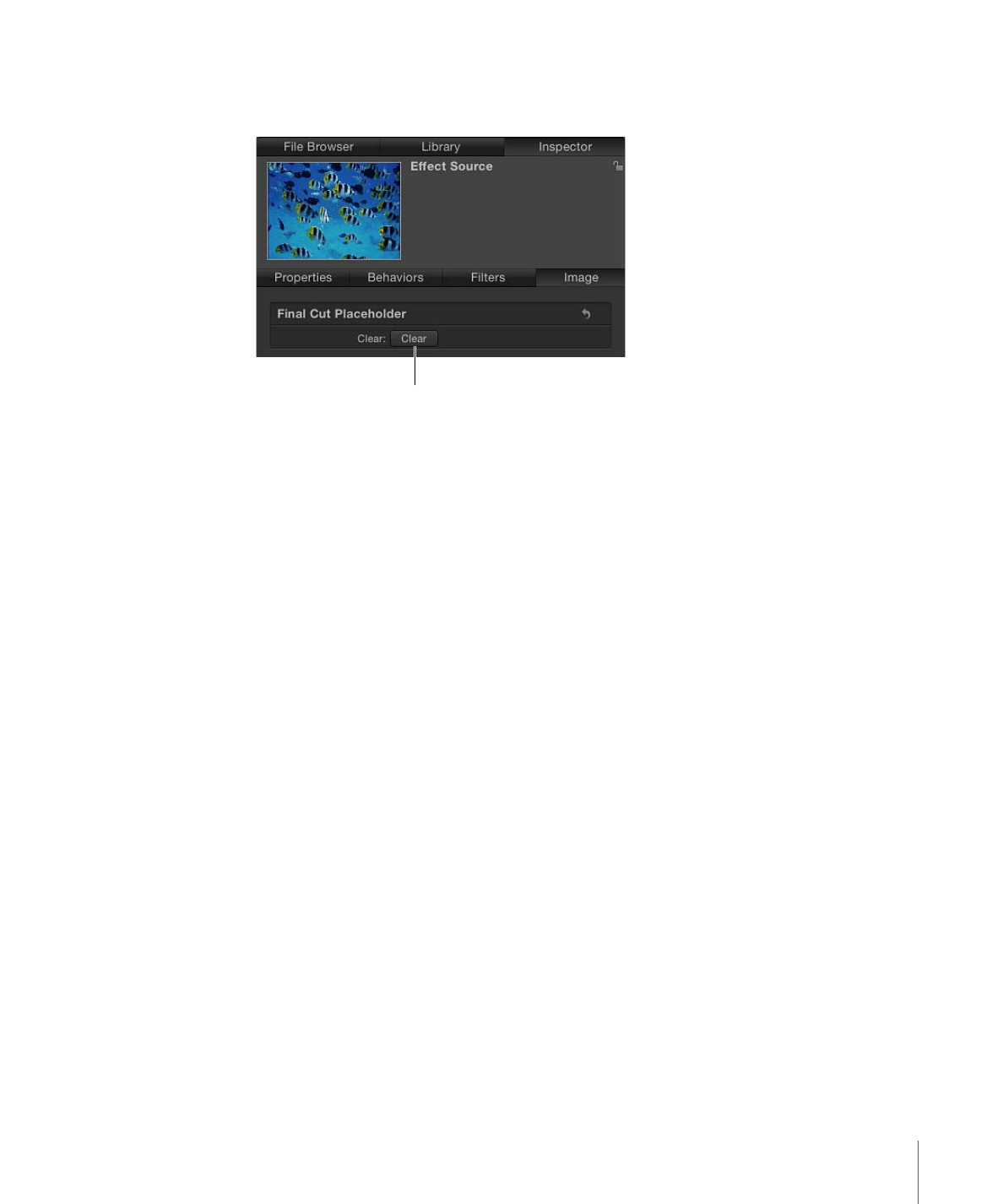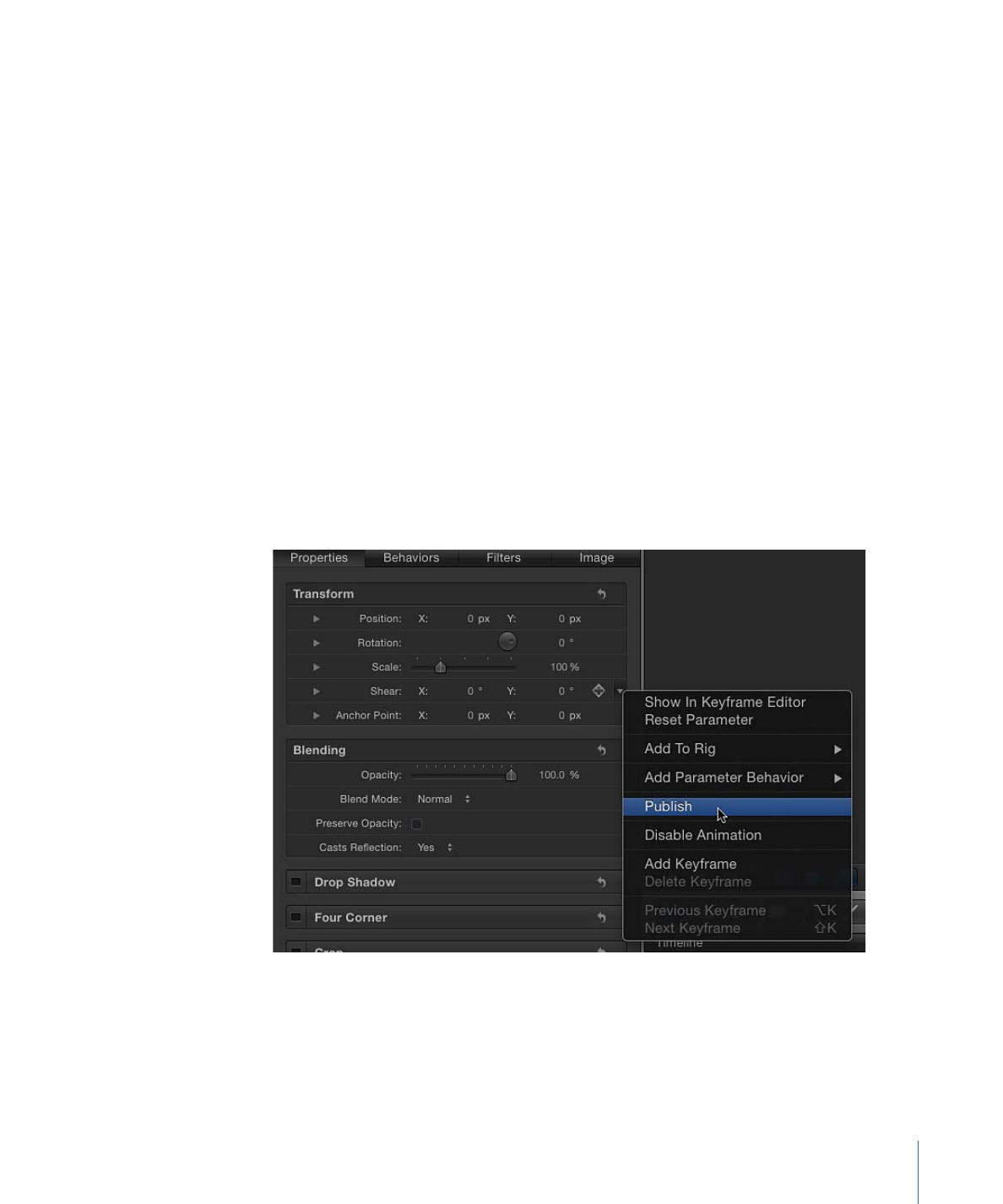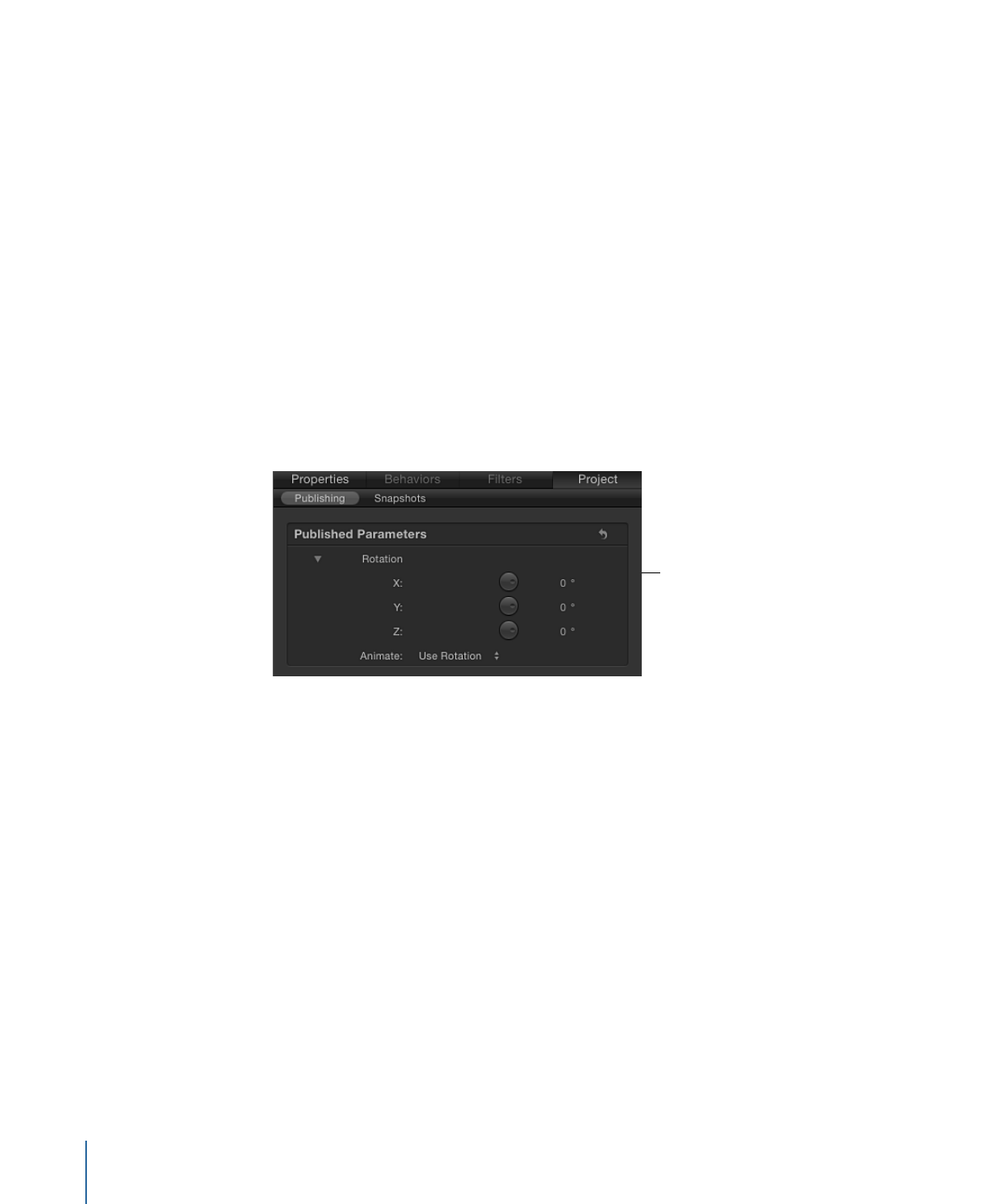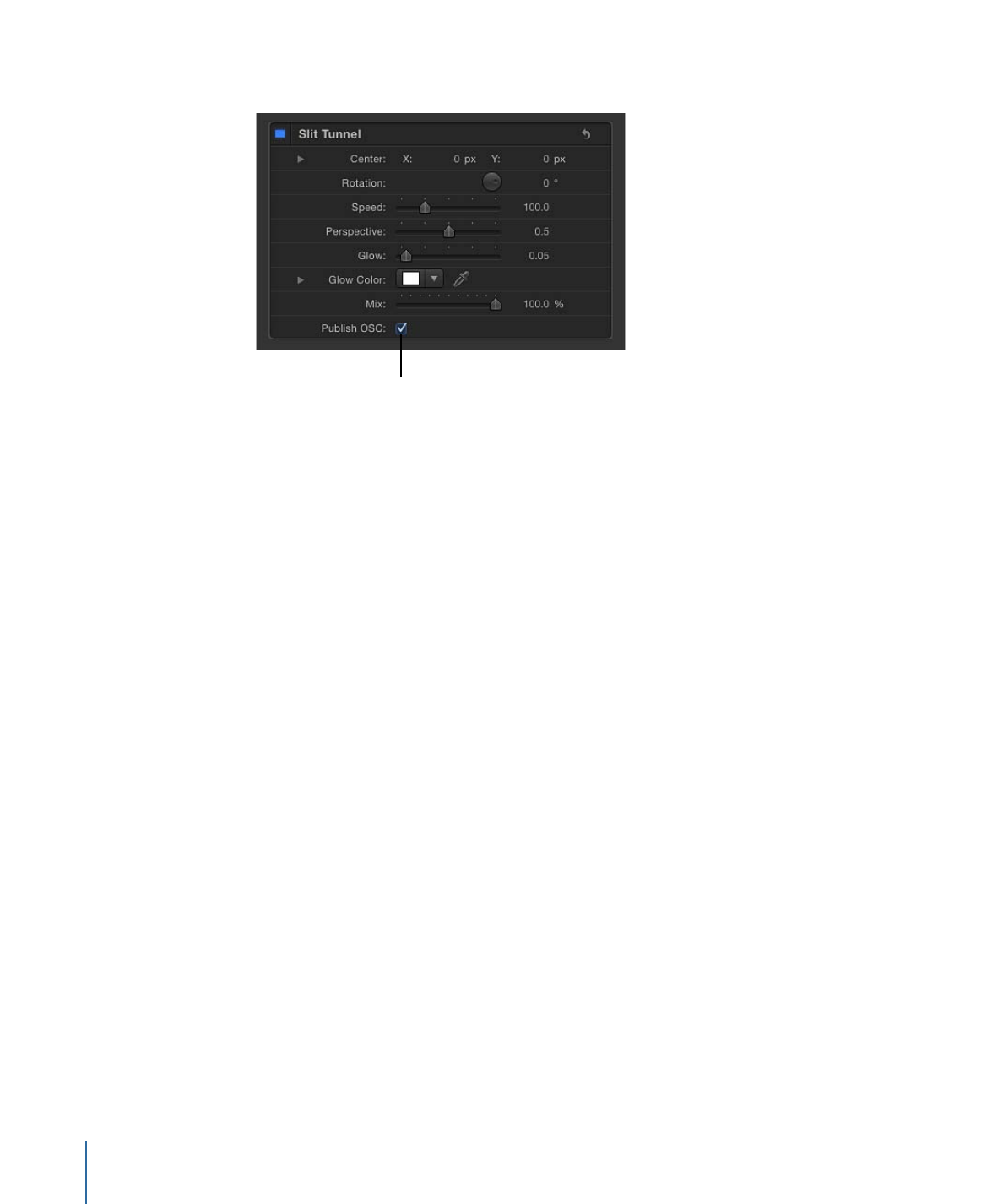
Publishing Parameters in Templates
When you create a template (an effect, transition, title, or generator) for Final Cut Pro X,
you can publish nearly any parameter. Publishing a parameter places its user interface
control (a slider, dial, checkbox, and so on) in the Final Cut Pro Inspector, where it can be
adjusted to modify an applied effect, transition, title, or generator. Publishing parameters
also lets you to decide how much control (if any) a Final Cut Pro user has over modifying
an an effect.
The easiest way to publish a parameter from Motion to Final Cut Pro is to choose the
Publish command from the parameter’s animation pop-up menu (the downward arrow
on the right side of a parameter row in the Inspector). When you save the template, the
published parameter is exported with the effect to Final Cut Pro.
541
Chapter 11
Creating Templates for Final Cut Pro X

When you publish a compound parameter (a parameter with nested subparameters), the
parameter and its subparameter controls appear in the Final Cut Pro Inspector, like any
other published parameter. If the subparameter controls are not visible, click the disclosure
triangle next to the parameter name in the Final Cut Pro Inspector to reveal them.
You can also publish onscreen controls for filters (in addition to filter parameters). When
you do so, onscreen controls for the published filter become available in the Final Cut Pro
Viewer.
Using Rigs in Templates
You can map multiple parameters to a single control in Final Cut Pro by adding rigs to
the template and publishing them. Rigs let you link parameters to a slider, pop-up menu,
or checkbox to simplify or limit the allowable adjustments in a Motion or Final Cut Pro
project. When you publish a rig control (known as a widget) in Motion, a master slider,
pop-up menu, or checkbox appears in the Final Cut Pro Inspector, enabling editors to
make complex effect adjustments with simplified controls. For more information about
rigs and widgets, see
Using Rigs
.
In addition to publishing parameter controls, you can publish a checkbox that lets
Final Cut Pro users toggle the effect of a filter or behavior used in the template. You do
this in Motion by publishing the header row (the row with the blue activation checkbox)
of a behavior or filter. When the template is saved in Motion and applied to a clip in
Final Cut Pro, a checkbox with the name of the published filter or behavior appears in
the Final Cut Pro inspector. Deselecting the checkbox disables the effect of that filter or
behavior (including its constituent parameters).
The following Motion items cannot be published in templates for Final Cut Pro:
• Image wells (except for drop zone Source Media wells).
• Mini-curve editors.
• Source Audio wells for the Audio Parameter behavior.
• Timing controls in the Image Inspector or Media Inspector.
• Retiming behaviors (such as Ping Pong, Loop, and Stutter).
• Some rig widget options (Slider: Range Minimum/Range Maximum).
• Project properties (such as Pixel Aspect Ratio, Frame Rate, and Background Color in the
Properties Inspector.)
• Graphs from the Keyer filter.
• Non-compound groups of controls, such as the Lighting parameter in the Properties
Inspector.
542
Chapter 11
Creating Templates for Final Cut Pro X

• The onscreen path for the Motion Path behavior. (Parameters can be published that
allow editing of the path in the Final Cut Inspector, but the path does not appear in
the Final Cut Pro Viewer.)
In general, Motion lets you publish most parameters in the application. However, some
publishable parameters are not supported in Final Cut Pro. The following items have
components that are not accessible after a template is added to a Final Cut Pro project:
• Parameters related to text path onscreen controls
• Mask or shape control points
• Parameters with deselected activation checkboxes
• The Histogram in the Levels color correction filter
To publish a parameter in a template
1
In the effect, transition, title, or generator template, select the image layer, filter, or
behavior containing the parameter to publish.
2
In the selected item’s Inspector, do one of the following:
• Click the parameter’s Animation menu (the downward triangle that appears when you
place the pointer over the right side of the parameter row), then choose Publish.
• Control-click the parameter’s name, then choose Publish from the shortcut menu.
To publish a compound parameter (a parameter with nested subparameters)
1
In the template project, select the image layer or effects object containing the compound
parameter to publish.
543
Chapter 11
Creating Templates for Final Cut Pro X

2
Open the selected item’s Inspector.
To publish a compound parameter to Final Cut Pro in a collapsed state (its subparameters
hidden by a disclosure triangle), make sure the parameter's disclosure triangle is closed.
To publish a compound parameter in an expanded state (disclosure triangle open and
its subparameters exposed), make sure the parameter’s disclosure triangle is open.
3
Do one of the following:
• Click the parameter’s Animation menu (the downward triangle that appears when you
place the pointer over the right side of the parameter row), then choose Publish.
• Control-click the parameter’s name, then choose Publish from the shortcut menu.
The parameter and its subparameter controls are published. When the template is
applied to a clip in Final Cut Pro, the compound parameter retains its state (collapsed
or expanded) at the time of publishing. If the result is not what you expected, click the
disclosure triangle in the Final Cut Pro Inspector to expand or collapse the subparameters
manually.
Published Rotation
parameter in the
Publishing pane of
the Motion Project
Inspector
Note: Examples of parameters with subparameters include Scale (with X, Y, and Z values)
and Shear (with X and Y values).
You can also publish specific subparameters of a compound parameter. This is a good
way to limit an editor’s control over effects parameters in Final Cut Pro project.
To publish subparameters of a compound parameter
1
In the template project, select the image layer or effect object containing the subparameter
to publish.
2
In the item’s Inspector, click the compound parameter’s disclosure triangle to show its
subparameters.
3
For each parameter to publish, do one of the following:
• Click the parameter’s Animation menu (the downward triangle that appears when you
place the pointer over the right side of the parameter row), then choose Publish.
• Control-click the parameter’s name, then choose Publish from the shortcut menu.
The subparameter is listed in the Published Parameters list.
544
Chapter 11
Creating Templates for Final Cut Pro X

To publish an on/off checkbox for a filter or behavior
1
Select the filter or behavior whose activation checkbox you want to publish.
2
In the Behaviors or Filters Inspector, do one of the following:
• In the header row of the behavior or filter, click the Animation menu (the downward
triangle that appears when you place the pointer over the right side of the row), then
choose Publish.
• Control-click the behavior or filter name, then choose Publish from the shortcut menu.
Note: If you publish only the blue activation checkbox and no other parameters in the
behavior or filter’s group of controls, only the checkbox is published.
To publish a rig control (widget)
1
Add a rig to the template, assigning specific parameters to the rig’s widget controls.
For more information about building rigs, creating widgets, and assigning parameters,
see
Using Rigs
.
2
Select the rig, then do one of the following in the Rig Inspector:
• In the Checkbox, Pop-up, or Slider widgets, click the Animation menu (the downward
triangle that appears when you place the pointer over the right side of the widget’s
parameter row), then choose Publish from the shortcut menu.
• Control-click the Checkbox, Pop-up, or Slider parameter name, then choose Publish
from the shortcut menu.
To publish a gradient editor
1
In the template project, select the image layer or effect object that contains the gradient
editor to publish.
2
In the item’s Inspector, Control-click the Gradient parameter, then choose Publish from
the shortcut menu.
Gradient editor controls are published when the template is saved.
To publish a filter’s onscreen controls
1
In the template project, select the filter object.
545
Chapter 11
Creating Templates for Final Cut Pro X

2
In the Filters Inspector, select the Publish OSC checkbox.
Select the Publish OSC
checkbox to publish the
filter’s onscreen controls.
The Inspector parameters that onscreen controls manipulate are not published with the
template. To control the parameters numerically when the template is added to a
Final Cut Pro X project, the parameters must also be published.
For more information about filter onscreen controls, see
Adjusting Filter Onscreen Controls
and
Publishing Filter Parameters and Onscreen Controls
.
Note: To animate onscreen control values in the Final Cut Pro X curve editor, the onscreen
controls must be published.
To review parameters set to be published in a template
1
In the Layers list, click Project.
2
In the Project Inspector, click Publishing.
Parameters (for all object types) set to be published appear in the list.
To reorder parameters in the Publishing pane
1
In the Layers list, click Project.
2
In the Project Inspector, click Publishing.
3
Drag a parameter up or down in the Published Parameters list.
To customize a published parameter name in a template
1
In the Layers list, click Project.
2
In the Project Inspector, click Publishing.
3
In the Published Parameters list, double-click the name of a parameter, enter a name,
then press Return.
Note: To navigate to the originally published parameter (before the name change),
Control-click the parameter and choose Reveal Original Parameter.
546
Chapter 11
Creating Templates for Final Cut Pro X

To unpublish a parameter in the Inspector
µ
In the image layer or effect object’s Inspector, do one of the following:
• Click the parameter’s Animation menu (the downward triangle that appears when you
place the pointer over the right side of the parameter row), then choose Unpublish.
• Control-click the parameter name, then choose Unpublish from the shortcut menu.
To unpublish a parameter in the Publishing pane
1
In the Layers list, click Project.
2
In the Project Inspector, click Publishing, then do one of the following:
• Click the Animation menu (the downward triangle that appears when you place the
pointer over the right side of the parameter row), then choose Unpublish from the
shortcut menu.
• Control-click the parameter name, then choose Unpublish from the shortcut menu.